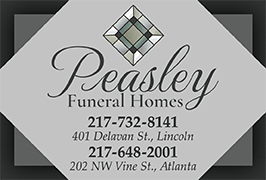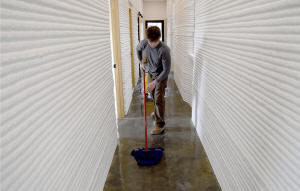3D printed and factory-built homes could help tackle housing crisis
[March 26, 2025] By
JESSE BEDAYN
DENVER (AP) — As Americans struggle under backbreaking rental prices,
builders are turning to innovative ways to churn out more housing, from
3D printing to assembling homes in an indoor factory to using hemp —
yes, the marijuana cousin — to make building blocks for walls.
It's a response to the country's shortfall of millions of homes that has
led to skyrocketing prices, plunging millions into poverty.
"There’s not enough homes to purchase and there’s not enough places to
rent. Period," said Adrianne Todman, the acting secretary of the U.S.
Department of Housing and Urban Development under former President Joe
Biden.
One way to quickly build more is embrace these types of innovations,
Todman said. “I can only imagine what our housing situation would be
like now if we could have made a decision to be more aggressive in
adopting this type of housing."
So what are these new ways of building homes? And can they help reduce
the cost of new housing, leading to lower rents?
Factory-built housing put together in a week
In a cavernous, metal hall, Eric Schaefer stood in front of a long row
of modular homes that moved through the plant, similar to a car on an
assembly line.
At a series of stations, workers lay flooring, erected framing, added
roofs and screwed on drywall. Everything from electrical wiring to
plumbing to kitchen countertops were in place before the homes were
shrink-wrapped and ready to be shipped.

The business in the Colorado Rocky Mountains, Fading West, has pumped
out more than 500 homes in its just over three years of operation, each
taking just five to seven days to build, even in the coldest winter
months, Schaefer said.
Once assembled in the plant, the narrow townhouse-style homes with white
trim, balconies and front porches, are about 90% done. At their final
destination they are move-in ready within six weeks, Schaefer said.
The company works with towns, counties and housing nonprofits to help
address the shortage of affordable homes, mostly for workers who've been
squeezed out by sky-high prices in ritzy mountain towns.
That includes Eagle, Colorado, not far from the Vail ski resort, where
Fading West worked with Habitat for Humanity to install modular homes at
affordable rents for teachers and other school district employees. The
homes tend to be on the smaller side, but can be multifamily or single
family.
“You can build faster. The faster you build — even at a high quality —
means the lower the price,” Schaefer said. “We see this as one of the
pieces to the puzzle in helping solve the affordable housing crisis."
There's a hefty upfront cost to build the factory, and part of the
challenge is a lack of state and federal investment, he said. A
patchwork of building codes governing how a structure can be built also
makes it difficult, requiring changes to the construction depending on
the town or county it is being sent to.
Manufactured housing is similar to modular housing, but the units are
constructed on a chassis — like a trailer — and they aren't subject to
the same local building codes. That's part of the reason they are used
more broadly across the U.S.
Roughly 100,000 manufactured homes were shipped to states in 2024, up
from some 60,000 a decade earlier, according to Census Bureau data.
Estimates of modular homes built annually often put them below 20,000.
3D printing is innovative but still 'a long game’
Yes, there's technology to 3D print homes.

[to top of second column] |

David Leach mops the floor of a 3D-printed concrete home built by
VeroTouch in Buena Vista, Colo., on Feb. 19, 2025. (AP Photo/Thomas
Peipert)

A computer-controlled robotic arm equipped with a hose and nozzle moves
back and forth, oozing lines of concrete, one on top of the other, as it
builds up the wall of a home. It can go relatively quickly and form
curved walls unlike concrete blocks.
Grant Hamel, CEO and co-founder of VeroTouch, stood inside one of the
homes his company built, the wall behind him made out of rolling layers
of concrete, distinct to a 3D printer. The technology could eventually
reduce labor costs and the time it takes to build an abode, but is
farther off than manufactured or modular methods from making a dent in
the housing crisis.
It's “a long game, to start chipping away at those prices at every step
of the construction process,” Hamel said.
The 3D printers are expensive, and so are the engineers and other
skilled employees needed to run them, said Ali Memari, director of the
Pennsylvania Housing Research Center, whose work has partly focused on
3D printing. It's also not recognized by international building codes,
which puts up more red tape.
The technology is also generally restricted to single-story structures,
unless traditional building methods are used as well, Memari said
It's “a technology at its beginning, it has room to grow, especially
when it is recognized in code,” Memari said. “The challenges that I
mentioned exist, and they have to be addressed by the research
community.”
A hemp-and-lime mixture called hempcrete has ‘a bright future’
Hemp — the plant related to marijuana — is being used more and more in
the construction of walls.
The hemp is mixed with other materials, most importantly the mineral
lime, forming "hempcrete," a natural insulation that's mold- and
fire-resistant and can act as outer wall, insulation and inner wall.
Hempcrete still requires wood studs to frame the walls, but it replaces
three wall-building components with just one, said Memari, also a
professor at Penn State University's Department of Civil and
Environmental Engineering. Memari is now helping oversee research into
making hempcrete that doesn't need the wood studs.

As much as a million hemp plants to be used for hempcrete can grow on
one acre in a matter of months as opposed to trees, which can take years
or decades to grow.
The plant is part of the cannabis family but has far less of the
psychoactive component, THC, found in marijuana. In 2018, Congress
legalized the production of certain types of hemp. Last year, the
International Code Council, which develops international building codes
used by all 50 states, adopted hempcrete as an insulation.
Confusion over the legality of growing hemp and the price tag of the
machine required to process the plant, called a decorticator, are
barriers to hempcrete becoming more widespread in housing construction,
Memari said.
Still, he said, “hempcrete has a bright future."
___
Associated Press video journalist Thomas Peipert contributed to this
report from Buena Vista, Colorado.
All contents © copyright 2025 Associated Press. All rights reserved |